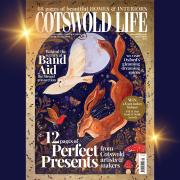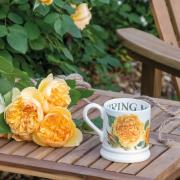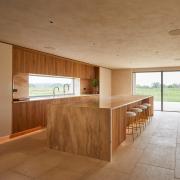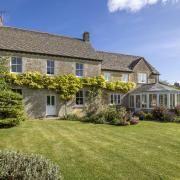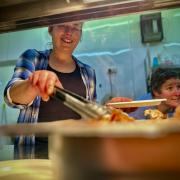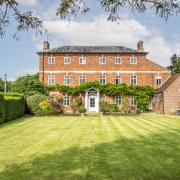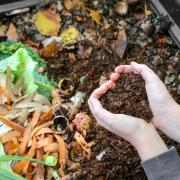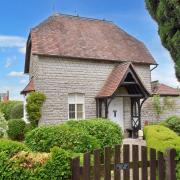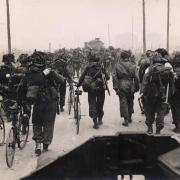Founded, 125 years ago on Tolstoyan principles, the Cotswold community at Whiteway still intrigues with its wild beauty and anarchistic ideals
It’s a glorious Sunday in June – heavy flower-heads nodding; bees drowsy with heat – and Whiteway Colony, in the hills above Stroud, has an open-gardens event.
(Many places have open gardens, you might respond! Ah, yes. But Whiteway is not ‘many places’.)
Visitors are flocking in their hundreds. They’ve come because they’re deeply curious; because they’ve heard of this singular enclave: bang on their doorstep yet as rarely glimpsed (some might say) as a ghost orchid.

It feels, as they park their cars and venture down wild footpaths, as if they’ve entered a parallel universe. Because here is a community built on principles like no other. For one thing, no one owns the plot their house sits upon. Why? Well, back in the day, the original ethically-minded settlers of these 41 acres ceremonially burned the deeds: private ownership of land was anathema. What’s more – just like the founders – the 120-or-so residents who live on this no man’s land today still make decisions together. They work freely and cooperatively to maintain their joint facilities – a playing field; swimming pool; the colony hall. They gather each month for drinks and pizza.
A little bit of paradise.
Yet, as the Sunday incomers meander from garden to garden, another kind of singularity strikes them. That thought has nothing (well, perhaps nothing) to do with the colony’s philosophy or radical ideas so at odds with the loneliness and capitalism defining much of 21st-century life.
No.
It’s rather that, as the visitors stand in the generous gardens fat with oxeye daisies, all they can hear are birds; insects; wild grasses rippling; an occasional cat’s-paw breeze across lily-strewn ponds.
Another kind of paradise.

MARGARET HAWKES is welcoming people to the undulating garden that wraps around her low house on Whiteway.
The incipient chatter encapsulates the thoughts of many who have come to visit today. ‘It’s a community you hear and read about but you don’t get chance to see,’ someone murmurs, as they brush past the age-old rose that winds like a warm greeting round the gate-fence.
But as these curious day-trippers begin to look around this delightful space, the conversation morphs. ‘I love your potentilla! Why can’t I get them to grow!’
Margaret has lived on Whiteway for 53 years. She and her late husband, Michael, had recently married and were searching for somewhere rural when they spotted a small, private ad in the Stroud News & Journal.
‘It said “House and studio for sale”. As we were both artists, that was exactly what we wanted. We came and thought, ‘Wow!’’
That was the good news. There was more complicated news to follow.
‘We didn’t realise that you couldn’t get a mortgage [on a Whiteway property]. The people who sold us the house obviously knew. I think they were seeing if we were serious when they said, “Try and get a mortgage. If you can’t, then come back.” Of course, the mortgage people told us not to touch it with a barge pole.’
The young couple had no chance of raising cash by other conventional means. In their 20s at the time, their wages were far from princely. (You can see two of the pub-signs Michael painted for a living: at Fostons Ash and at the Woolpack in Slad: faded over time, but beautiful still. Margaret specialised in animal portraits and natural history subjects, sold through galleries and via commissions.)

‘So, we did go back. And the people selling offered us a private mortgage.’
Did the financial complexities put them off?
‘Not at all. We loved the tranquillity. And the community were delightful.’
Within that story, however, lies one of the ironies of Whiteway. Any buyer today will have to dig deep into their pockets for hundreds of thousands in ready cash. No high-street lender will touch a house without deeds.
Yet that wasn’t the intention of those who founded the colony back in 1898 – 125 years ago this year.
THE EARLY YEARS of Whiteway tell a story well worth reading (try, if you can get them, the now out-of-print Nellie Shaw’s Whiteway: A Colony on the Cotswolds (she being one of the four earliest settlers, who went on to live there the rest of her life); or Joy Thacker’s Whiteway Colony (Joy being a current resident)).
These colony pioneers were motivated partly by Tolstoyan principles; partly by deeply-held beliefs in socialism, freedom, community, equality. What’s more, they wanted somewhere as immune from government rules as they could possibly create.

One of their number, Samuel Bracher, was a journalist from Gloucester; he had inherited £1,000, which – as ‘unearned’ money – weighed on his conscience. It was part of this money that was used to buy the Whiteway land, along with seeds and tools in a bold attempt at self-sufficiency. The subsequent burning of the deeds – on a pitchfork – was a highly visual gesture to capitalist convention.
‘The main principle Whiteway was founded on was that land shouldn’t be in private hands,’ says Whiteway resident, David Harris.
Still, quite a drastic action, burning deeds?
‘You have to think back to 1898, when it started: things were very different. In the early days, houses here were very simple, often self-build. You were granted your land; if you wanted to leave, you could take your house away. Not that many people did. If it was a roughly-built shack, it wouldn’t have lasted long anyway. Over the years, of course, people stayed longer; built more substantial houses.’
We’re sitting in David’s garden – a gorgeously cultivated wilderness of pink-flower arches, splodges of pastel, dayglo, primary colours; a sinuous house topped by plant-strew roof: sedums; juicy wild strawberries for birds to harvest.

When he and his partner Imogen arrived here in the late 90s, the house was a Heath Robinson assemblage of different eras, standards and needs.
‘Like many of the properties on Whiteway, it began its life humbly. Right in the middle is the original bit: 12ft x 24ft – similar to an army hut – put up in 1940 by a family from London escaping the Blitz.’
(Pretty cramped for a family. But you can see what they gained other than indoor space.)
David and Imogen’s local-architect-designed improvements include robust insulation, a heat pump and solar panels: ‘All the stuff we can to make it more efficient and eco-friendly.’
Yet…
They’ve invested relatively large sums of money into a house with no deeds?
‘I don’t believe in using domestic houses as a source of profit-generation. I don’t want to be part of that system, although it’s difficult not to be.’
In software and marketing before he retired, David is now editor of the Parish Post (the Miserden magazine) and Whiteway Colony secretary. People come to him with problems and requests. He receives applications from would-be residents.
‘We have colony meetings on a regular basis – necessary but a bit dry. We don’t grow crops together like they used to, but we do have a great community spirit: social nights, special meals – curry, Mexican, soup and pudding; sports days in summer; the swimming pool. These are the things that keep the community together.’

THE OVERRIDING principle all colonists share today is that of non-land-ownership. But – as the history trail curated for the open gardens shows – there’s also community pride in Whiteway heritage. (Indeed, generations of former colonists still live here.)
That heritage is particularly rich in crafts.
‘By the 1920s, a lot of people in Whiteway were making a living through crafts,’ says Mary Greensted, expert in the Arts and Crafts movement. ‘There was a weaver; there was the Dodo Press that did printing and a lot of design work; Peter Evans was one of the very good furniture-makers there.’
Some became founder members of Gloucestershire Guild of Craftsmen, of which Mary is chair.
She shows me a pair of all-leather sandals crafted by Stanley Randolph, working there in the 1930s. (Once people had worn them, he’d say, they’d never go back to shoes.) And steel spoons made by Alan Evans – the aforementioned Peter’s son – who died in January: ‘One of the best artist-blacksmiths in the country’. The spoons defy adequate description: at one and the same time, they transcend centuries past and future in their sensuous design.
With Mary’s help, I make contact with Alan’s widow, Lesley Greene, who is kindness itself, generous with her time.
She describes how Alan’s grandparents, Mary and Basil Robert, were invited from Holt, Norfolk, “Where they lived in an Iron-Age pole-hut”, to set up a craft-economy at Whiteway; Mary (a teacher specialising in forest schools) was also asked to establish a school. The two had met when Basil became a conscientious objector during the First World War, and Mary a visitor.
‘And so there’s context with regard to something wider – quite political, in a sense, and aligned with a lot of the original Whiteway principles,’ Lesley says; ‘to do with what your life is in the world; how you need to respect the environment and people’s opinions; and also to take those opportunities for the use of your gifts in the service of the greater community.’
Joy, the Roberts’ daughter – who died earlier this year – was a wood-carver; she married Peter, the furniture-maker, who had relatives at Whiteway.

Their son, Alan, studied metalwork, but predominantly jewellery, at Shoreditch College; he found his true vocation during an apprenticeship in Worcestershire with Alan Knight, one of the great artist-blacksmiths of the post-war period.
‘There was a strong commitment [for Alan], certainly from his father, to the quality of the Cotswold tradition,’ Lesley says. ‘But I think Alan was more like his mother. We have dishes she made in organic, natural forms; she did deep-relief carving [highly skilful, intricate work], very different from the formal furniture-making that Peter practised.’
Alan was adventurous in his own right, introducing innovations that led to huge respect within the blacksmithing community and beyond.
‘He always said that jewellery was his craft but blacksmithing his art.’

Alan’s work encompassed the small – his chestnut roaster was deemed (by award-winning blacksmith Richard Quinnell) the best design ever – while the gates Alan forged for the crypt treasury of St Paul’s Cathedral – echoing the beauty of its stone ceiling – cemented his place as a national artist of outstanding renown.
‘When he did big public commissions, he was keen to ensure that the aspect of forged metal was evident to you if you touched it. Something tactile; something ‘human’.’
Alan worked from his forge in Whiteway, though he and Lesley never actually lived in the colony. ‘Because we couldn’t. I even had a regular job [Lesley is an arts consultant] but we still couldn’t get a mortgage.
‘I see that as a problem. The colony has not turned down in the whole of its history in favour of a child in the colony having the option to buy in favour of someone with the money.’
A DILEMMA. But, certainly, there is no shortage of would-be residents, who embrace the principles with sincere and genuine warmth; residents for whom money is not a driving factor. Among the most recent are Sue Spielberg and Richard Sales, who have built an extraordinary property to Passivhaus (net-zero) standards. The grounds – Sue trained at Kew – are a haven for insects.
Ernest Nelson and his wife Julie – a retired vicar – bought here five years ago, both committed to community living. ‘We have ideas about how we ought to live, and this fits in,’ Ernest – Whiteway Colony chair – says.

Standing in their garden doesn’t seem too far from Nirvana.
‘Paradise means somewhere with a garden,’ Julie nods.
Newest of all are Vanessa and Steve Price. He’s a firefighter who grew up in Stroud, visiting grandparents who lived near Whiteway. (His grandfather was a postie who used to deliver to the colony.) She a part-time estate agent and keen Instagrammer with some 25,000 followers, who posts stunning photos of her new life.
‘We were looking at moving, and a house became available about four years ago – but we couldn’t sell ours in time. It was the first time we’d thought about Whiteway.’
That thought took hold, and the couple patiently waited for years for another property to come onto the market.
‘I really like communities. I was a town councillor for 10 years in Stroud: the whole ethos of Whiteway is important to me and my husband. On a more practical level, the houses are on generous plots, which we liked, as well as the quirkiness of the wooden houses.’
The scariest bit, Vanessa says, was the meet-and-greet. ‘It’s a bit like speed-dating because one couple will come up and talk to you; they move on and someone else takes their place! But it wasn’t a grilling at all, and it was all done over tea and cake.’
The Prices are now well established – with a vegetable area, a kunekune pig in the orchard, and great plans for the house.
‘It’s home. You can’t hear the roads. All you can hear are birds. We absolutely love it.’




